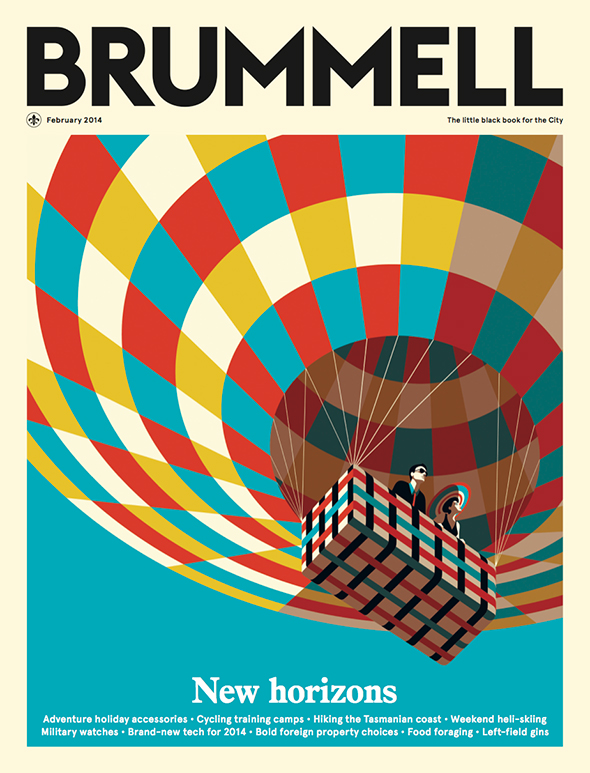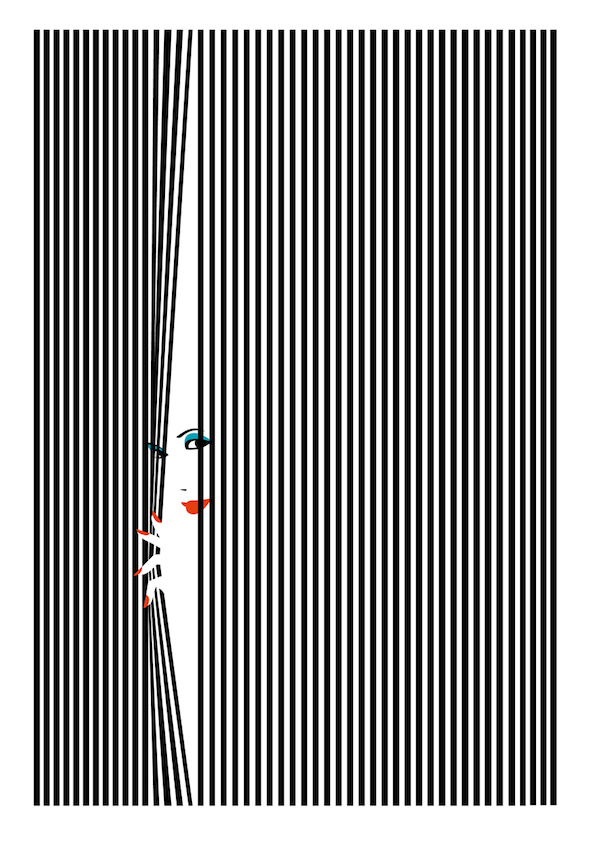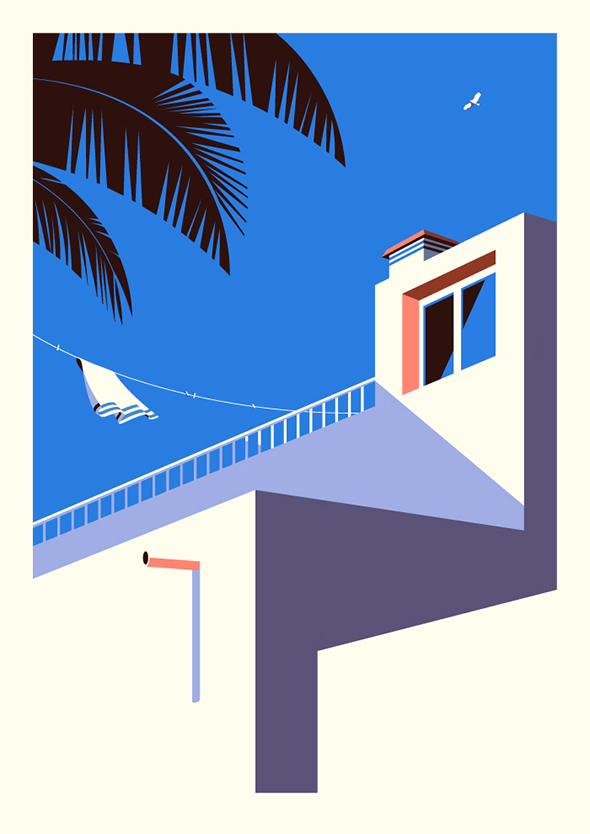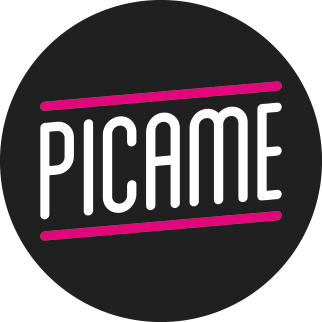[English version along the post]
Cresciuta a Parigi ma londinese d’adozione, con uno stile raffinato e minimalista capace di creare immagini tanto essenziali quanto fortemente evocative, Malika Favre é un’artista dall’enorme potenza visiva e una superstar dell’illustrazione contemporanea.
Allo splendore delle sue creazioni va anche il merito di saper affrontare ogni argomento con un linguaggio agile ed elegante, riuscendo lì dove molti altri fallirebbero. Siamo entrati nella sua affollata agenda per realizzare questa intervista esclusiva, la prima rilasciata da Malika ad una magazine italiano, in cui l’artista ci ha raccontato i vari aspetti del proprio percorso, dagli inizi francesi alla definizione del complesso metodo di lavoro, solo in apparenza minimale, alla scelta di trasferirsi a Londra e di avvicinarsi a temi erotici, con la disponibilità e la gentilezza che sono alcuni dei suoi mantra, e che lei applica alla lettera.
Quando guardo il tuo lavoro vedo molti rimandi alla cultura visiva del ‘900: la propensione per le silhouettes anni ’80, lo stile optical dei ’60, l’uso delle forme geometriche nella costruzione dell’immagine proprio del Bauhaus. Sono influenze effettivamente presenti nella tua ispirazione?
Credo siano influenze implicite piuttosto che coscienti. Il mio modo di lavorare è organico e per molto tempo l’ho ritenuto istintivo, solo in un secondo momento ho capito che giorno per giorno mi nutrivo di immagini, oggetti e cose piacevoli ai miei occhi e che queste influenze in qualche modo stavano alimentando la mia immaginazione, caratterizzando il lavoro che avrei prodotto in seguito. Sono una grande fan di Bridget Riley, un’appassionata ammiratrice di ogni cosa che concerne il Bauhaus e mi piace l’audacia di ogni aspetto degli anni ’80, come ad esempio la musica. Per quanto riguarda gli anni ’90, beh, sono cresciuta in quel decennio 😉 Esiste un legame molto stretto tra quello che disegno, quello che indosso e quello che trovo bello o emozionante, è tutto intrecciato.


Quali sono i tuoi modelli di riferimento nella ricerca e nella costruzione di uno stile personale?
Principalmente le persone che hanno fantasia e con una forte personalità. Da Miranda July, a Louis CK, a mio padre. Non devono essere per forza artisti, solo persone che non hanno paura di rischiare.
Ho letto che il disegno è stata per te una vocazione precoce, stimolata dall’educazione ricevuta da tua madre, pittrice. Hai sempre teso alla raffinata semplicità che contraddistingue il tuo lavoro o è il frutto di una decisione che hai preso e di un conseguente cambiamento di stile?
La decisione di percorrere la strada minimalista è stata presa molto più tardi in realtà. Credo che l’unica cosa che è rimasta invariata da quando disegnavo da bambina sia il mio amore per i colori netti. Credo che in realtà sia necessario disegnare ogni singolo dettaglio per sapere quali poi estrarre, quindi i miei primi disegni risultavano molto realistici e decisamente accademici.



Le tue illustrazioni riescono a suggerire la complessità di ciò che ci circonda attraverso l’uso di pochi elementi geometrici sapientemente disposti. Qual’è il punto di partenza nella costruzione delle tue immagini?
Il processo è quello della riduzione, per attuarlo ho sempre bisogno di molti elementi per iniziare. La prima cosa che faccio è spargere grandi aree di colore per poter percepire l’equilibrio di forme e colori. Poi disegno le varie forme molto liberamente, fin quando raggiungo una composizione che risulti ben bilanciata. Fatto ciò inizio a perfezionare i dettagli per poi rimuoverli uno per uno al fine di semplificare l’immagine il più possibile.
Hai lavorato 6 anni come designer presso Airside, per poi intraprendere la carriera di freelance. Cosa ti ha portata a prendere questa decisione? Hai incontrato qualche ostacolo lungo il percorso?
Gli anni in Airside sono stati incredibili e ho imparato molto. Lavorare in uno studio, collaborare, ricevere feedback e spingere oltre il mio ego è stato fondamentale per me e ha veramente aiutato la mia successiva vita da freelance. Per quanto mi fosse piaciuto lavorare a Airside, ad un certo punto ho sentito il bisogno di fare di testa mia e realizzarmi come illustratrice. Ho deciso quindi di diventare indipendente ed oggi posso dire di non essermi mai pentita di questa scelta, nemmeno per un’ora. Non è stato un cambiamento traumatico per me. Ho firmato un accordo con Handsome Frank praticamente subito e avevo da parte abbastanza risparmi da non dovermi preoccupare per quei primi mesi di transizione. Credo anche di avere avuto fortuna perché non ho praticamente mai smesso di lavorare, e ad oggi è ancora così 🙂



Ti sei stabilita a Londra da diversi anni ormai: in cosa è diversa da Parigi? Esiste di una “scena londinese” per l’illustrazione?
C’è un posto per ogni creativo qui. È tutto mescolato in un gigantesco, emozionante calderone; questo è ciò che amo di Londra. La maggior parte dei miei amici sono designer, ma pochi di loro sono illustratori. Per quanto riguarda il lavoro, può provenire da qualsiasi luogo. A volte dal Regno Unito dove la cultura visiva è molto forte, ma anche da Stati Uniti, Francia, Giappone. Ho sempre percepito il fatto che a Londra importa quello che fai, non chi conosci… lo stesso non si può dire di Parigi 😉 ma io sono di parte…
Un tema ricorrente nei tuoi lavori è l’erotismo: dal Pin-Ups Alphabet alle varie versioni del Kama Sutra, tutti hanno una sorprendente capacità di rimanere in bilico tra sensualità ed eleganza, senza mai eccedere. Cosa ti ha portato a trattare di questo argomento?
Non mi sorprendo quando riguardo schizzi e disegni fatti durante l’adolescenza; ho sempre amato disegnare il corpo umano e non ho mai considerato il sesso come un tabù, anche perché vengo da una famiglia abbastanza aperta. Credo che la necessità di trattare questo tema sia nata dalla mia frustrazione nel vedere quanto male venisse interpretato. In realtà nasconde tanta bellezza ma poche persone riescono a rendersene conto, così ho accettato la sfida. Reinterpretare la sensualità sarà sempre qualcosa che amerò fare, ma dopo la mostra Kama Sutra ho deciso di smettere, almeno per il momento, e mantenere quell’aspetto del mio lavoro separato dal resto. In attesa del progetto perfetto per proseguire 😉


A successo ormai raggiunto a livello internazionale, quali obiettivi ti poni per il futuro? Hai dei sogni che non hai ancora realizzato?
Mi sento in un posizione in cui posso rilassarmi ma purtroppo il relax non fa parte del mio DNA così il massimo che posso fare è cercare, in futuro, di lavorare meno ottenendo un miglior equilibrio vita-lavoro. Concentrarmi su un minor numero di progetti ma divertirmi ancora di più 🙂 In questo momento mi piacerebbe diventare un illustratore itinerante, ed essere inviata in tanti luoghi che potrei così scoprire e disegnare.
Che consigli dai a chi volesse intraprendere la tua strada?
Lavorate sodo, siate gentili con le persone (Grazie Anthony Burrill), non siate snob, commettete errori, andate avanti.






—
ENG
Grown in Paris but Londoner by adoption, with a refined and minimalist style able to create essential and strongly evocative images, Malika Favre is an artist with an enormous visual power and a superstar of contemporary illustration. The merit of knowing how to face each subject in an agile and elegant language and of succeeding where many others would fail, goes to the beauty of her creations. We entered her busy agenda to realize this exclusive interview, the first issued by Malika to an Italian magazine, in which the artist told us about the various aspects of her course, from the beginning in France to the definition of her complex working method, only apparently minimalist, to the choice to move to London and get closer to erotic themes, with the availability and kindness that represent some of her strictly applied mantra.
When I look at your work I see many references to the visual culture of the ‘900: the propensity for 80s silhouettes, the optical style of the 60s, the use of geometric shapes in the construction of the proper image of the Bauhaus. Are these influences actually present in your inspiration?
I guess these are underlying influences more than conscious ones. The way I work is very organic and for a long time I considered it very instinctive but I later realised that I was feeding of images, objects and things that please my eye on a day to day basis and that those influences somehow nurtured me and my imagination and could be found in the work I would produce later on. I am a huge fan of Bridget Riley, a keen admirer of anything Bauhaus and I love the boldness of anything 80’s, as well as the music. As for the 90’s, well, I grew up in that decade 😉 There is a very tight link between what I draw, what I wear and what I find beautiful or exciting so it’s pretty much all intertwined.
Which are your role models in research and construction of a personal style?
Mainly people with a vision and a strong defining personality. from Miranda July to Louis CK to my dad even. It doesn’t have to artists at all in fact, only people that don’t shy away from risk.
I have read that drawing was for you an early vocation, stimulated by education received from your mother, a painter. Have you always tended to the refined simplicity that distinguishes your work or is this the result of a decision you’ve made and of a consequent change of style?
The decision of going down that minimalistic route came much later actually. I guess the only thing that remained unchanged since I was drawing as a child is my love for bold colours. I believe that you actually need to draw every single detail to know which ones to then take out so my early drawings were very realistic and almost academic.
Your illustrations are able to suggest the complexity of what surrounds us by the use of a few geometric elements cleverly arranged. What is the starting point in the construction of your images?
The process is one of reduction so order to reduce I always need more to start with. The first thing I do is throw big areas of colours around and have a feel for the balance of shapes and colours. I draw the elements very loosely until I reach a composition that feels together. Once that is done I go back in and draw every detail perfectly before removing them one by one until I can’t reduce the image anymore.
You’ve been working five years as a designer at Airside, then you started a career as a freelance illustrator. What brought you to this decision? Did you encounter any obstacles?
The Airside years were amazing and a great learning curve. Working in a studio, collaborating, taking feedback on and pushing your ego aside were crucial for me and really helped my freelance life after that. As much as I loved working at Airside and the whole family we had there, I came to the point where I felt I needed to do my own thing and really push my voice as an illustrator. I found myself there and once it happened there was no going back so I decided it was time to set up as an independent illustrator. I haven’t regretted my decision even for an hour.
The transition was actually a very smooth one for me. I got signed by Handsome Frank pretty much straight away and had saved enough not to worry too much about those couple of months. I guess I got lucky 😉 Work hasn’t stopped coming in since so no obstacles so far…
You’ve been living in London for several years: what is the difference with Paris? There is a “London scene” for illustration?
There is a scene for everything creative here. It is the same actually, all mixed into a giant exciting bowl and this is what I love about London. Most of my creative friends are designers but very few are illustrators. As for the work, it can come from anywhere really. I sometimes comes from the UK as the visual culture is very strong but also comes from the US, France, Japan or anywhere really. I always felt London was about what you do no matter who you know… the same can’t be said about Paris 😉 but then I am bias…
A recurring theme in your work is the eroticism: from the Pin-Ups Alphabet to the various versions of the Kama Sutra, all of these works have an astonishing ability to remain in the balance between sensuality and elegance, without ever overdoing it. What brought you to treat this subject?
It didn’t come as a surprise when I look back at my teenage sketches and drawings, I have always loved drawing the human body and never felt sex was a taboo. I come from a pretty open family as well. I think the need to treat that subject and really explore erotic themed pieces came from my frustration of seeing really bad stuff out there. There is such beauty in that and yet, few people manage to get that accross so I took on the challenge. It will always be something I love doing but I feel that I have pushed it as much as I needed too so decided to stop after the Kama Sutra exhibition and keep that side of the work detached from the commercial part for now. I am waiting for the perfect project to come along 😉
Ascertained your international success, what goal do you aim to achieve in your future. Do you have dreams not yet realised?
I feel I am in a place where I can relax, and should relax but unfortunately that is not part of my DNA so I am kind of aim to work less and get a better work life balance in the future. Take on less projects but enjoy them even more 🙂 Right now I would love to become a travelling illustrator of sorts, being sent to places to discover and draw.
What kind of advice would you give to those who want to travel your road?
Work hard, be nice to people (Thanks Anthony Burrill), don’t be a snob, make mistakes, move on.






